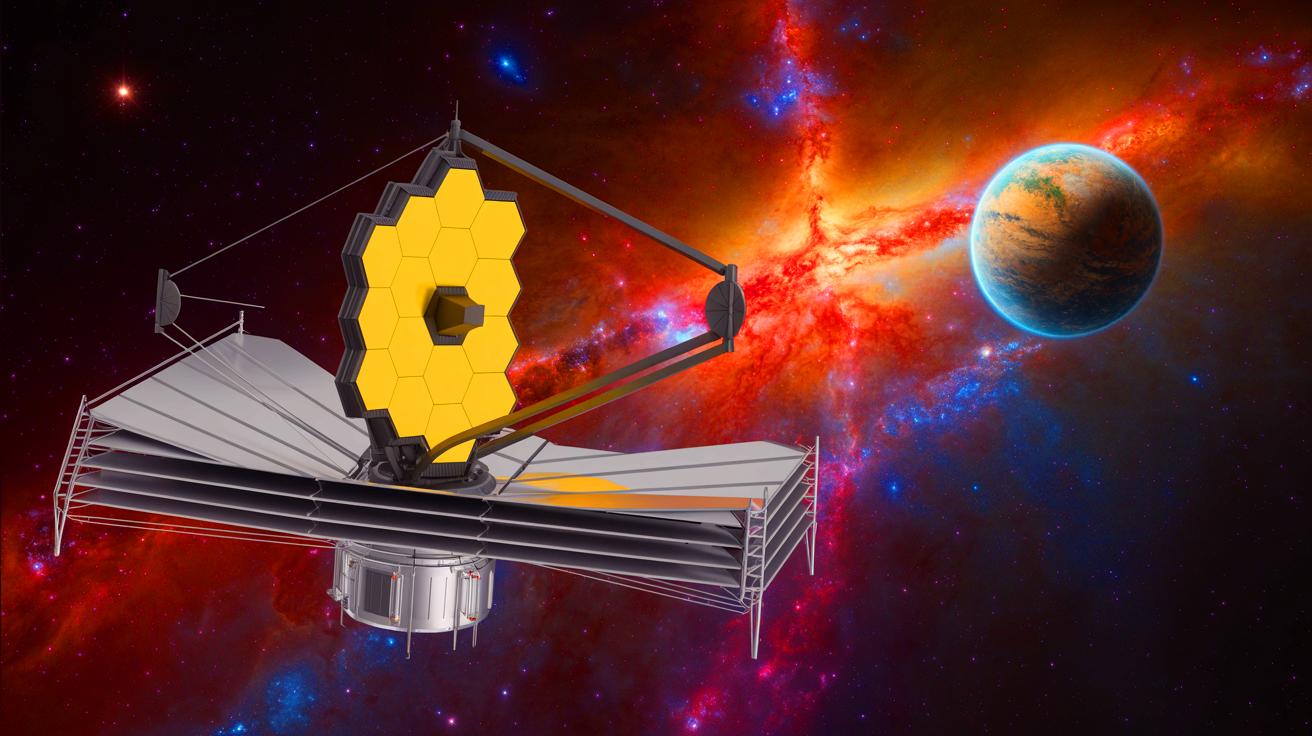IN A NUTSHELL
🌌 The James Webb Space Telescope captured a direct image of the exoplanet 14 Herculis c, located 60 light-years from Earth.
🔍 Using a coronagraph, the telescope isolates the faint light of exoplanets from the bright glare of their host stars.
🌀 The inclined orbit of 14 Herculis c suggests significant past gravitational interactions within its planetary system.
🌡️ The exoplanet’s atmosphere contains gases like carbon dioxide and carbon monoxide, indicating complex atmospheric processes.
The James Webb Space Telescope (JWST) has once again made headlines by capturing a direct image of 14 Herculis c, a distant exoplanet located approximately 60 light-years from Earth. This monumental achievement not only highlights the capabilities of the JWST but also opens new avenues in the study of planetary systems beyond our own. The exoplanet, orbiting a Sun-like star, presents intriguing features, including an unusual inclined orbit and a complex atmosphere. Through advanced techniques, scientists are now able to isolate and study the faint light emitted by these distant worlds, bringing us closer to understanding the universe’s vast diversity.
How the JWST Captures Images of Exoplanets
The James Webb Space Telescope utilizes state-of-the-art technology to observe exoplanets, employing methods that allow it to overcome the challenges posed by the brightness of host stars. One of the critical tools used in this process is the coronagraph. This device effectively blocks out the overwhelming light from the stars, making the faint glow of surrounding planets detectable. This is particularly important because exoplanets typically emit light in the infrared spectrum, which is a range the JWST is specially equipped to observe.
By focusing on infrared light, the JWST can reveal details about planets that would otherwise remain concealed from view. The telescope’s capabilities extend far beyond simple detection. Scientists can employ sophisticated models to analyze the atmospheric composition and structural details of these distant worlds. This approach opens new avenues for understanding the diversity of planetary systems, offering insights into the formation and evolution of planets in the universe.
Why Is the Orbit of 14 Herculis c So Unusual?
The orbit of 14 Herculis c stands out due to its inclination, offering a glimpse into the turbulent past of its planetary system. This atypical orbit indicates that 14 Herculis c may have experienced significant gravitational interactions, potentially involving another planet that was expelled from the system. Such interactions are key to understanding the dynamics within young planetary systems.
By analyzing these unusual orbital characteristics, scientists can reconstruct the history of the system, shedding light on the processes that may have shaped our own Solar System. Understanding these cosmic dynamics provides valuable insights into how planets migrate and settle into their current orbits. The study of such phenomena is crucial for piecing together the complex puzzle of planetary formation and stability.
The Atmospheric Mysteries of 14 Herculis c
14 Herculis c presents a fascinating atmospheric profile that defies initial expectations. With an estimated atmospheric temperature of about 27°F, this exoplanet is cooler than initially anticipated. Its dim brightness compared to predictions suggests the presence of unique atmospheric processes, potentially involving gases such as carbon dioxide and carbon monoxide.
The detection of these gases offers crucial clues about the planet’s atmospheric composition and dynamic processes. Understanding these components is vital as they can significantly affect the planet’s climate and potential habitability. The presence of such gases suggests a complex atmospheric chemistry, which may differ markedly from existing models of planetary atmospheres. This complexity calls for further research to unlock the mysteries of distant worlds and gain a deeper understanding of their environments.
The Implications of This Discovery
The discovery of 14 Herculis c represents a significant milestone in the field of exoplanetary research, showcasing the JWST’s pivotal role in advancing our knowledge of the universe. By enabling the exploration of colder and older worlds, this discovery underscores the importance of continued investment in space exploration technology. The JWST’s ability to provide a more profound understanding of exoplanets not only enriches our scientific knowledge but also ignites curiosity about the possibility of life beyond Earth.
As we delve deeper into the secrets of the cosmos, we are reminded of the universe’s vastness and complexity. This discovery prompts us to question what other wonders remain hidden, waiting to be unveiled by future generations of astronomers. What new technologies and techniques will be developed to further push the boundaries of our understanding of the universe?
This article is based on verified sources and supported by editorial technologies.
Did you like it? 4.5/5 (22)

